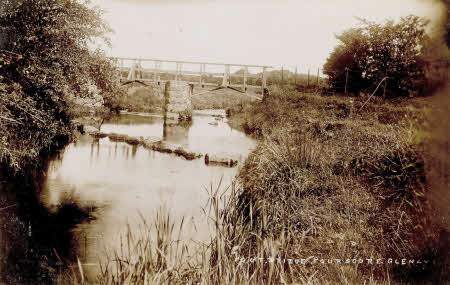
“Bings.”
PART ONE
THE DIGGER

An early 20th century postcard depicting the original footbridge across the river in the townand of Ballymoneymore, outside Glenavy. The stepping stones can also be seen in the picture.
I have often heard the story of local children in the district stepping off a local bus onto a “bing” of stones in a stone recess at the side of the road. This occurred about sixty years ago. When the story was first related to me the word “bing” grabbed my attention.
According to the 1930 edition of Chambers Scots Dialect Dictionary the word refers to “a crowd, a heap or pile.” The word now appears to have slipped from the vocabulary of the younger generation. I have heard the word used locally when referring to a pile of stones, sand or wood. Former generations referred to the “potato-bing” The famous bard, Robbie Burns, himself used the phrase in “The Bings of Ayr” - “Potatoe-bings are snugged up frae skaith….”
In 1842 Ann and Jane McBride from the Moira area were arrested and brought before Downpatrick Crown Court for the alleged theft of a quantity of potatoes believed to have been taken from what was referred to as a “potato-bing.” It was reported that these ladies were obliged to commit the act out of distress and hunger. They were imprisoned for three months and given hard labour. It would not be the only court where the word bing appeared. In June 1898 a resident of Ballinderry, County Antrim appeared before Lisburn Magistrates Court charged with an alleged stabbing. A police officer told the court that when he interviewed and subsequently cautioned the accused, he replied that the complainant had “fell out with him at the Lime Kiln” and threw him on “a bing of stones” and struck him on the face.
The word “bing” also appears in chapter five of “The 39 Steps” by John Buchan. When the main character encounters a roadman with a hammer at the roadside breaking up a “bing o’stanes.” A similar roadman breaking stones at the roadside in Antrim is also featured in Alexander Irvine’s “My Lady of the Chimney Corner.” The author describes his encounter with Willie Witherow, the roadman, and he adds that he possessed “a strange mixture of philosophy and cynicism.”
Stone breaking, whilst a necessity in the repair and making of roads prior to the introduction of machinery in the late 19th century, was also used as a form of hard labour inside prison establishments. A report on the Belfast House of Correction, published in 1829, stated that “the profit on the stone-breaking nearly repays the county for the food of the prisoners.” A later report in 1862 described this form of prison work as “dreary and degrading.” In 1870 the Belfast Newsletter reported that the Belfast Workhouse also had a stone breaking Yard.” In 1879 the Belfast relief Committee were informed that a large body of men had sought employment, and that the labour committee unhappily had to send most of them away. Initially they were only able to provide 20 men with employment as stone breakers, after purchasing hammers and stones and making provision for a place to break them.
In the 1830’s the Ordnance Survey memoirs for the district inform us that leading roads, kept by presentments and partly by five year contracts, averaged 21 feet in width. Smaller roads referred to as by-roads were averaging 14 to 17 feet in width and loanins or loanends were 10 - 14 feet in width. In some areas materials for building and repair of the roads were in abundance and located close by. It was reported that in some areas field stones, broken by a hammer, or gravel and trap rocks from local rivers were taken by cart to where they were required. In the 17th century the repairing of roads was overseen by local parishes who called on the assistance of local farmers and labourers and compelled them to provide 6 days unpaid labour. Cesses and turnpikes were some of the former methodology used to raise money for the funding the construction of new roads.
Expansion of the road systems in the district can be found by examining old maps. Some modern main thoroughfares today in the district were, surprisingly not in existence some 100 - 150 years ago. Those of us who took the time to listen to a previous generation may have heard a number of names applied to local roads - “The Broad Road”, “The New Line”, “The New Cut” and “The New Road.” In fact, there are roads in the Lisburn district constructed some 20 years ago still referred to locally as “the new road”, despite having been given a name.
Notices to road contractors appeared regularly in the local press inviting tenders for the laying of new roads or the repairing of existing roads. One example, appearing in the press in February 1854, states “to make 364 perches of a new line of road from Crumlin to Lisburn, by Stoneyford, between Cadger’s Lane and Steed’s Lane, in the townlands of Tullyrusk and Ballymacward Lower not to exceed £300.” “Cadger’s” or “Codger’s” Lane is a name still used locally when referring to that area, in the townland of Ballymoneymore, despite the road having since been named “Fort Road.” It was originally a lane with stepping stones across the Fourscore River. In 1900 Lisburn Rural District Council passed a motion to have a footbridge erected over the river. Later that bridge would be replaced by a more permanent structure.
The Digger can be contacted by email: diggerarticle@hotmail.com
PART ONE | PART TWO | PART THREE
14/03/2012
